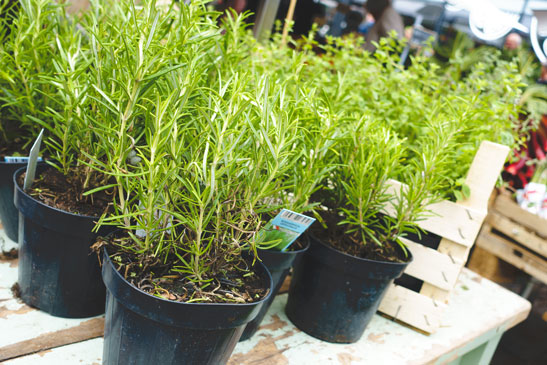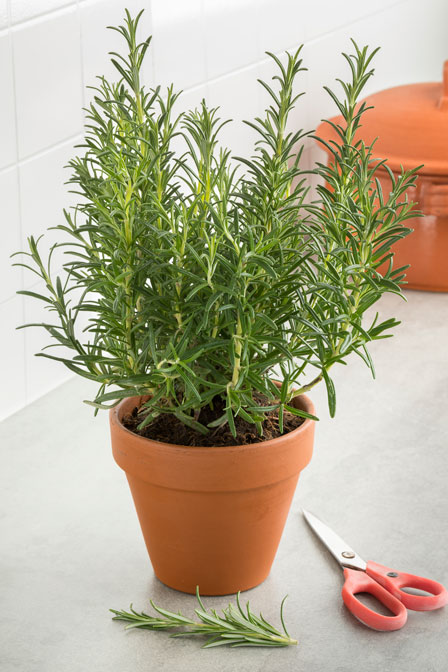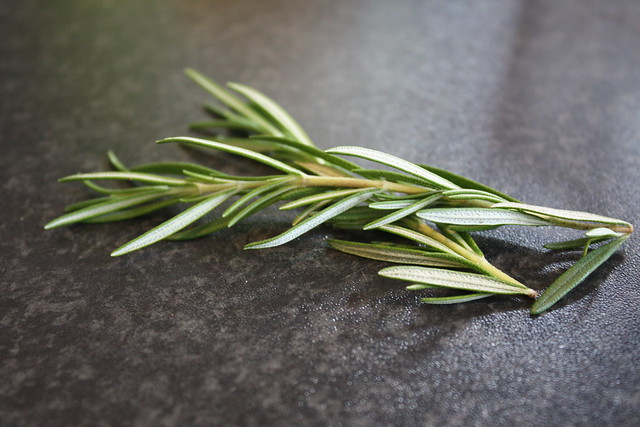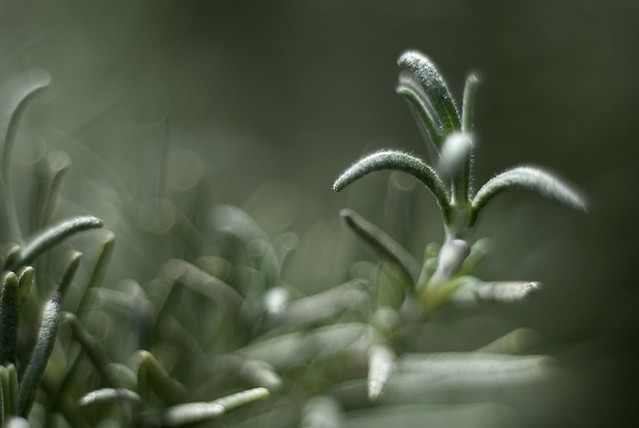You probably want to learn how to grow rosemary after tasting it in a savory dish.
This perennial plant is popular for its aromatic and distinct taste. It has a combination of lemon-pine aroma and bitter-sweet flavor.

It goes well with your favorite type of meat, whether chicken or steak and even different types of soups.
One dash of rosemary could elevate the taste and goodness of the dish.
This woody-stemmed plant with needle-like leaves could be your go-to spice since it’s easy to use and grow.
That’s why I have them in my garden. Whatever your gardening case, you could grow this too.
For starters, it is easy to plant, grow, and harvest. This plant would be perfect for professionals or people who wants to start a gardening hobby.
I have my rosemary plant for seven years now and it continues to yield beautiful fragrant leaves perfect for different dishes.
It usually needs warmer weather conditions, so I place it indoors during the winter to survive the extreme weather conditions.
While it may not thrive during winter, it usually grow beautiful foliage during the summer.
That’s why planting should be done in the spring or summer. Even harvest is done during these two seasons since they grow beautiful foliage.
Ready your tools and notebook, I’m going to teach you the secret to having a healthy and long lasting rosemary plant.
Grow You Own Rosemary at Home
Rosemary plant is perfect for beginners in gardening. It is easy to plant, grow, maintain, and harvest.

You won’t be needing a lot of fertilization and preparation for this plant.
In fact, you could leave it in your window sill or porch and it would still remain beautiful and fragrant.
The beautiful flowers and bushy form is also loved by some gardeners. They are also used on landscaping gardens.
Moreover, it also grows on different weather conditions and gardening conditions.
You could also place it in different locations, whether pots of gardening beds.
But if you live in colder areas, you should place it in pots for it to survive the winter season.
If you don’t have the time and skills yet, then this would be perfect for you. In fact, this is one of the first plants that I have grown myself.
And guess what? It’s actually a great plant to start because you get to understand the process of planting and growing a plant, even with little amount of work put into it.
Apart from its culinary uses, this plant is also used in soaps, cosmetics, and lotions.
Studies also show that rosemary plant has other health benefits good for you.
Examples include increase in memory retention, relieves muscle pain, and improves hair growth and many more.
You also get to keep the excitement since the maintenance is really easy, you are sure that you will harvest great foliage.
It may not be the most rewarding plant harvest you would encounter, but the first harvest is really something we should look forward to.
This plant is definitely one of the best plants to grow because it could also solve some of your pest problems in your garden.
Rosemary plants act as a natural insect and animal repellent which would benefit a lot of plants when planted near it.
From Plant to Harvest Your Rosemary
Are you excited to plant your very first rosemary plant?
Get that vibe going because now I will teach you some of the materials and preparation that would make this gardening project a success.
Should I use rosemary seeds, seedlings or transplant?
Rosemary could be planted in three ways. You could start from scratch and use seeds, or your could buy seedlings from nursery to skip the seeding and germination.
Lastly, you could plant cuttings from a mature plant directly to soil.
While seeding would be exciting since you’re starting from the very beginning, germination takes a lot of time.
On the other hand, using seedling might also be risky since it might contain diseases that might hinder the growth of your rosemary plant.

That’s why cuttings are the best option since you already have a head start in planting.
Rosemary plant has different varieties and types. You may encounter plants with white, blue, or violet flowers.
Here are some of the benefits of planting rosemary cuttings:
1. Earlier Harvest
Since you planted cuttings instead of seeds, you are way ahead. That’s why you would expect a faster harvest. Moreover, seeds have a low chance of germination and really takes time to germinate.
2. Same as Mother Plant
You have the liberty to choose the model rosemary plant for your very own rosemary plant. Therefore, you could choose a healthy plant, that is free from pest damage and diseases.
Just choose the right variety that grows well with your climate.
Find a mature healthy plant as your mother plant. Cut 4 inch pieces of the plant for the cuttings.
There you go, you’re ready for planting.
When is the best time to plant rosemary?
Just like other plants, the timing of planting is also as important.
Planting rosemary needs a 70 degrees Fahrenheit (21 degrees Celsius) for root growth and germination.

However, this plant works well with direct sunlight, so after the first step, growth should be timed in summer.
With that, cuttings should be planted eight to ten weeks before the last spring frost in your area.
Gardening calendar is not always the same in different areas. Growing this plant right depends on your timing as well.
The right time to plant rosemary cutting depends on your area. Therefore, the right time to plant is not universal. Normally, planting is preferred in the late spring, but for warmer climates, rosemary cuttings should be planted in early autumn.
You could also visit this link to see the gardening calendar for your area.
What is the best container to use when planting rosemary?
You will need two pots for this plant.
First pot will be used for the cuttings and the other for transplanting.
For the cuttings, you will need small pots, a 4-inch in width pot shall be used for the stem cuttings.

Since the cuttings will just start to grow roots, this would just fit the purpose.
Meanwhile, for the transplanted cuttings, find a bigger pot.
Rosemary plants tend to grow up to one to three feet high. Transplant the plant into bigger pots once the roots start to invade the whole pot.
Based on my own experience, I usually repot at least once a year. I transfer the plant into a bigger pot to make room for the growth of the roots.
How do I prepare the soil for planting rosemary?
Rosemary plant needs a well-draining soil. Although they need moisture once in a while, it is still best for this plant to grow in a well-draining soil.
This plant cannot stand a wet soil every time. That’s why I recommend a sandy soil mix.
You could achieve this by mixing all-purpose potting soil and sand with equal amounts together. You could also try out a cactus-potting soil.
This plant do not normally need fertilizer, but for best results, I personally recommend this potting mix induced with nutrients.
How do I plant rosemary?
Before planting the stem cuttings into the soil, remove the leaves from the lower part of the stem.
This is approximately one inch from the lowest part of the stem cutting. This is to prevent the stems from rotting which let the roots grow.
Put the cuttings in a jar with room temperature water. The water supplies dissolved oxygen into the stem helping it grow and prevent it from rotting.
Place the water in a warm place, not in direct sunlight.
Replace the water once in a while. After a few weeks (four to eight weeks), remove the rosemary cuttings that wilted and retain the healthy ones for planting.
Then, you’re ready to plant the cuttings.
As mentioned before, you could use a sandy soil mix or a nutrient-induced potting mix. It really depends on your preference. Just take note that the soil you used is well-draining.
Place one stem cutting into the pot by making a 1 to 2-inch hole into the soil.
Gently plant the rosemary cuttings into the soil.
Then, cover the cuttings by pressing the soil compactly but gently. Water the soil, afterwards.
Soil should be at around 70 degrees Fahrenheit or 21 degrees Celsuis for conducive germination.
You could also place the pot into a plastic bag to maintain the temperature for germination.
Make sure that you poke holes in the plastic bag, so air needed by the plants is still served.
In addition, I also dip the tip of the rosemary stem cuttings into a rooting powder for faster and easier rooting.
Growing Rosemary
How and when do I thin my rosemary plant?
You won’t need to thin your rosemary plant since it was not planted through direct seeding.
Because we used cutting, thinning the plant won’t be necessary.
However, it is best to re-pot the plant every so often since this plant has big roots and could invade, or worse, outgrow the pot.
I highly recommend to re-pot this plant into a bigger pot.
How can I properly water my rosemary plant?
This plant is a low-maintenance plant and vigorous. It actually does not need much care and maintenance than other plants.
Based on my own experience, I usually plant my rosemary plant whenever the soil is already dry.
You see: once this plant has established its roots into the soil, it does not want long exposure to damp soil.
Just like other plants, over-watering might cause the plant to rot, while under-watering could also cause death on the plant.
Just remember to water you plants, only when at least one inch of the top soil is dry.
Which fertilizer should I use for my rosemary plants and when do I use it?
Rosemary plant does not need fertilizer.
This is another proof that this plant does not need much caring.
Normally, it just needs lime in the soil to maintain the soil pH that is conducive for growing a rosemary.
Also, you could use the potting soil induced with nutrients available on Amazon, and the nutrients needed by this would really not be a problem.
How much sun does my rosemary plant need?
This plant works well indoors and outdoors, but it does not grow well in extremely cold weather. It still needs partial exposure to sun, which is six to eight hours.
That’s why I place the plant indoors during the winter and place it on my window sill during other seasons.
Which climate better suits rosemary? (Best Hardiness Zones)
This plant grows better in warm and humid environments unlike cold environments. It thrives in USDA Hardiness Zones 7 and warmers zones (8, 9 and 10).
It cannot withstand the cold weather , specifically temperatures below 30 degrees Fahrenheit ( -1 degrees Celsius).
So if you live in an area with extremely cold weather, that won’t be a problem in growing this plant.
You just need to place it indoors when the temperature drops to avoid wilting and rotting.
Once the temperature gets warmer, you may now place it again on your backyard or even your windowsill or porch (given that this plant does not need full sun exposure to thrive.
How long does it take to grow rosemary and what should I expect in each growing stage?
The growth stages of rosemary really depends on the planting technique you employed.
In our case, we used rosemary stem cuttings, so it is faster to grow and harvest.
Since we also gave an ample amount of time to moisturize the stems for root growth, this would also fast track the process.
It usually takes one year for rosemary cuttings to grow into a mature plant. This is the most ideal duration for rosemary plant to develop.
However, the leaves and stems that grows could also be used for cooking. You could start to get the leaves little by little when it grows up to four feet.
What are the common diseases and pests that could ruin my rosemary plant and how do I avoid it?
Be cautious also from pests and diseases that might hinder the growth of your plant. This might hinder your first harvest so be sure to watch out for the following diseases:
1. Spittlebugs
Spittlebugs are small insects which are colored brown. They attack the littled needles of rosemary by sucking the sap. Then, they surround themselves with white secretion.
Although this may not usually pose a big threat to your crops, heavy infestation may weaken the plant and may result in wilting.
You could easily manage these bugs by using a water hose with great pressure to wash off the white wads and the insects inside.
2. Aphids and Whiteflies
This insect is also a sap-sucking type. Aphids is usually in green color, but it could come as white, yellow, black, brown, and pink. On the other hand, whiteflies are obviously white insects.
They feed on the branches of rosemary. Just like the spittle bugs, use a water hose with high water pressure to remove them from the plants.
3. Root Rot
Root rot is caused by fungi. Once they’ve infested the roots, there’s not much that you could do. The damage transfers to the needles and even the stems, which in time results to wilting.
What you could do is to prevent this from happening by placing the plant in well-draining soil. Dry soil would prevent the fungi from growing into the roots.
4. Powdery Mildew
This is also caused by a fungi. This disease leaves spots in the stems and needles with white powdery substance.
To manage the disease, apply a fungicide spray. I personally find this fungicide spray helpful in getting rid of this disease. This is available in Amazon. Read the package label to learn more about the proper usage and application.
What other crops could I plant together with my rosemary?
If you want to maximize the space in your garden or in your home, there are certain plants that you could plant near rosemary.
The best plant you could plant near rosemary is cabbage loopers. Rosemary releases strong oils and aroma that repels the natural pests of cruciferous vegetables like broccoli, cauliflower, and kale.
Other notable plants could be planted in close proximity to rosemary are carrots and beans. With the same natural repellant characteristics, it is said that they increase the yield of this plant.
What are the crops that will not go well with rosemary?
Herbs like rosemary works well with other plants. Because they act as natural insect and sometimes animal repellant.
In this case, there are no known plants that would not work well with rosemary as companion in the garden.
Harvesting Rosemary
Now that we’ve already discussed preparation, planting, and maintenance of the plant. Let us move to the most rewarding and exciting part of gardening: the harvesting.
Ready your favorite meat products because a dash of freshly harvested rosemary would make your dish first class.
When is the best time to harvest rosemary?
Although you could harvest rosemary stems and needles anytime (as long as it has grown up to six inches tall), spring and summer is the best season to harvest the plant.
For instance, the cut stems from pruning could be used for your cooking.
This plant survives on different weather conditions, but it particularly thrives during spring and summer.
During these times, you’ll see the beautiful flowers growing and the needles flourishing.
Rosemary during the spring and summer contains the maximum oil content and flavor.
This is the perfect time to harvest rosemary since it would also replenish easily due to the amount of sunlight.
How do I harvest rosemary?
Are you ready to harvest rosemary? Just like pruning, you’ll need a kitchen shears for cutting and basket for storage. Ready your tools and let’s start harvesting!
Cut the top two – three inches of sprigs from the plant. Do not harvest the whole plant, since this plant is perennial.
This could still produce oil and aroma-infused rosemary sprigs in the next few years.
Just cut up to a third of the plant and maintain the remaining for the next harvesting season. This would allow the plant to grow for the next season.
What is the best way to store the rosemary that I have harvested?
There are three ways to store this plant and preserve its aromatic and flavorful characteristics. You may follow the following depending on your usage or preference:
1. Fresh Rosemary
If you want to preserve fresh rosemary and use it in your cooking, this procedure is for you. Just hang the rosemary sprigs outside to air-dry for several hours. After drying, bundle the prigs together and enclosed in a dry towel.
Place it in your refrigerator for fresh rosemary use. This could last up to five to seven days.
2. Dried
You could also DIY dried rosemary with these simple steps.
First, bundle the sprigs with a rubber band and hang them upside down to let it dry.Leave it outside for about 10 days.
Do not place it in direct sunlight as this might dry the sprigs than necessary.
Wait for the leaves to completely dry. Once these are dried, separate the leaves from the stems. Place it in a can with tight lids to preserve the leaves.
Place the date of harvest outside the jar as label.
3. Processed
You could also place it in butter, olive oil, or vinegar. Just follow the drying steps above and mix it with butter, olive oil, or vinegar depending on your preference.
Featured Table
| Botanical Name | Rosmarinus officinalis |
| Plant Type | Herb |
| Sun Exposure | 6 to eight hours |
| Soil Type | Sandy soil mix |
| Soil pH | 6 pH – 7 pH |
| Bloom Time | Summer |
| Flower Color | White, Blue, Violet |
| Hardiness Zones | 7, 8, 9, 10 |


